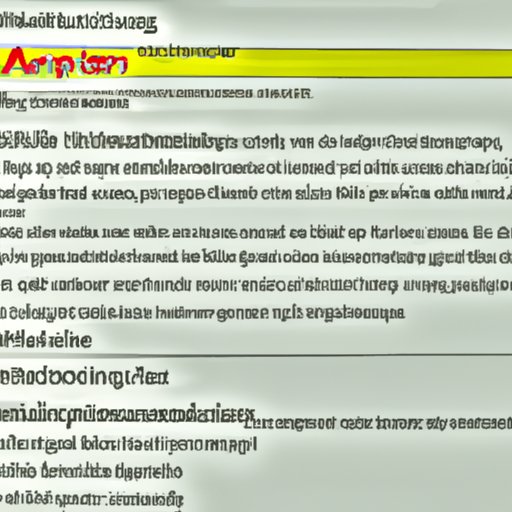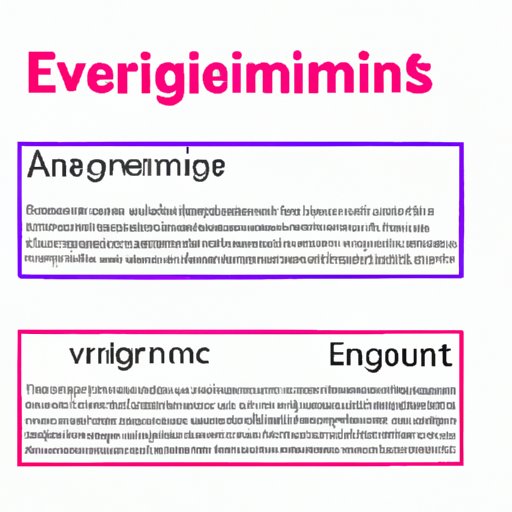Introduction
Argumentative writing is a form of writing that presents both sides of an issue and attempts to convince readers to adopt a specific stance on the subject. In this type of writing, making a claim is essential. A claim is a statement that expresses an opinion, belief or perspective on a topic. It is the main point that the writer wishes to make and is supported by evidence.

A. Definition of Claim in Argumentative Writing
A claim in argumentative writing is an opinion expressed by the writer, which is backed up by evidence. It is the focal point of the paper and provides the reader with clear direction on what the writer wants to argue. The claim should be specific, clear and concise. It should be able to capture the reader’s attention and give them an idea of what the paper will be about.
B. Purpose of a Claim in Argumentative Writing
The purpose of a claim in argumentative writing is to persuade the reader to accept the writer’s viewpoint. By making a clear, well-supported claim, the writer can effectively guide the reader through their argument and present their opinion in a logical and convincing manner. Claims are also important because they provide structure to an argument and help the writer organize their thoughts and evidence.
Body
I. Analyzing Different Types of Claims in Argumentative Writing
When constructing a claim in argumentative writing, it is important to understand the different types of claims that exist. Each type of claim has a different purpose and requires different kinds of evidence to support it.
A. Factual Claims
Factual claims are statements that express a fact or truth. These are the most common type of claim and are often used to support other claims. They can be supported by evidence such as statistics, research studies and expert opinions. For example, a factual claim would be “the average temperature in the United States has increased by 1 degree Celsius over the past century.”
B. Value Claims
Value claims are statements that express an opinion or judgment about something. These claims are more subjective than factual claims and require evidence such as personal experience, stories and expert opinions. For example, a value claim would be “climate change is a serious threat to our planet.”
C. Policy Claims
Policy claims are statements that suggest a course of action or solution to a problem. These claims require evidence such as statistics, research studies, laws and regulations. For example, a policy claim would be “the government should implement stricter environmental regulations to reduce greenhouse gas emissions.”
D. Causal Claims
Causal claims are statements that explain the relationship between two events. These claims require evidence such as research studies, experiments and expert opinions. For example, a causal claim would be “rising temperatures are causing more extreme weather events.”
II. Exploring How to Construct an Effective Claim in Argumentative Writing
Constructing an effective claim in argumentative writing requires careful thought and planning. By following these steps, writers can ensure that their claim is clear, well-supported and persuasive.
A. Understand the Issue
Before making a claim, it is important for writers to have a thorough understanding of the issue. This includes researching the topic, understanding different perspectives and gathering relevant evidence. By doing this, writers can gain insight into the issue and develop a deeper understanding of the arguments being made.
B. Choose Your Position
Once writers have a good understanding of the issue, they can begin to formulate their own position. Writers should take time to consider all sides of the argument and determine which position they feel most strongly about. This will help them create a claim that is clear and focused on the issue at hand.
C. Create a Logical Argument
After choosing a position, writers should create a logical argument to support their claim. This means clearly stating the claim, outlining the evidence that supports it and explaining how the evidence relates to the claim. By doing this, writers can ensure that their argument is well-structured and persuasive.
III. Examining Examples of Successful Claims in Argumentative Writing
By examining successful examples of claims in argumentative writing, writers can get a better understanding of how to create an effective claim. Here are three examples of successful claims:
A. Example 1
“Investing in renewable energy sources is the best way to reduce greenhouse gas emissions and combat climate change.”
B. Example 2
“Gun control laws should be strengthened to prevent mass shootings and protect innocent lives.”
C. Example 3
“Increasing the minimum wage would reduce poverty and improve the economic wellbeing of working families.”
IV. Understanding the Role of Evidence in Supporting a Claim in Argumentative Writing
In order for a claim to be effective, it must be supported by strong evidence. There are several steps writers can take to ensure that their evidence is credible and relevant to the claim. Here are three steps for finding and using evidence to support a claim:
A. Find Relevant Sources
Writers should start by researching the topic and finding reliable sources of information. They should look for sources that are written by experts or contain data from reputable organizations. This will ensure that the evidence is credible and relevant to the claim.
B. Make Sure the Evidence Is Credible
It is important for writers to make sure that the evidence they use is credible. They should check the sources to make sure they are reliable and trustworthy. They should also make sure that the evidence is current and up-to-date.
C. Connect Evidence to the Claim
Once writers have found credible evidence, they should connect it to the claim. This means explaining how the evidence supports the claim and why it is relevant to the argument. By doing this, writers can ensure that their argument is well-supported and persuasive.
Conclusion
In conclusion, a claim in argumentative writing is an opinion expressed by the writer, which is backed up by evidence. Different types of claims exist, each with its own purpose and requirements for supporting evidence. To construct an effective claim, writers must understand the issue, choose their position, create a logical argument and use credible evidence to support it. By following these steps, writers can create a compelling and persuasive argument.
of Key Points
This article explored the definition of a claim in argumentative writing, its purpose, different types of claims and how to construct an effective one. It also examined examples of successful claims and the role of evidence in supporting a claim.
B. Final Thoughts
Making a claim in argumentative writing is an essential part of presenting a strong and persuasive argument. By understanding the different types of claims, how to construct an effective one and the role of evidence in supporting a claim, writers can create powerful arguments that will convince readers to accept their point of view.
(Note: Is this article not meeting your expectations? Do you have knowledge or insights to share? Unlock new opportunities and expand your reach by joining our authors team. Click Registration to join us and share your expertise with our readers.)
